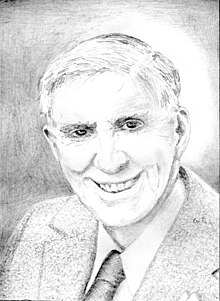Len Beadell
| Len Beadell | |
|---|---|

Len Beadell OAM, BEM, FIEMS
|
|
| Born |
Leonard Beadell 21 April 1923 West Pennant Hills, New South Wales, Australia |
| Died | 12 May 1995 (aged 72) |
| Nationality | Australian |
| Occupation | Surveyor and engineer |
| Known for | Outback road building |
Leonard (Len) Beadell OAM BEM FIEMS (21 April 1923 – 12 May 1995) was a surveyor, road builder, bushman, artist and author, responsible for constructing over 6000 km of roads and opening up isolated desert areas (some 2.5 million square kilometres) of central Australia from 1947 to 1963. Born in West Pennant Hills, New South Wales, Beadell is sometimes called "the last true Australian explorer".
Beadell's paternal grandparents came from England in the mid 1870s. His father Fred Algernon Beadell, was born in Sydney and mother Viola Pearl Mackay was from Townsville. They were married in Townsville in December 1914, and soon moved to the Sydney area. A daughter Phyllis was born in 1917, followed by Len in April 1923. Beadell's primary education began at Gladesville Public School, Ryde in 1928 and continued at Burwood Public School in 1930, both suburbs of Sydney.
At the suggestion of a school friend, Beadell joined the 1st Burwood Scout Troop where he met the scoutmaster John Richmond, who was to have a major influence on Beadell's life. Richmond had served in the army during World War I, and was employed as a draughtsman and surveyor for the Metropolitan Water, Sewerage and Drainage Board in Sydney. During the years 1931 to 1941, Beadell spent most weekends on bush survey trips with other scouts and Richmond, camping and searching for old survey marks. He learnt about the technical aspects of astronomical sightings and how to use a theodolite. In 1938 with a group of six scouts, Richmond took Beadell to Lord Howe Island where they took star sightings and determined that the mapped position of the island was out by about 10 kilometres in latitude.
Beadell finished his formal education at Sydney Grammar School in 1939, and went directly to a temporary surveying position with the water board in northern New South Wales, which had been arranged by Richmond.
At the age of 18 in 1941, Beadell received his call up notice for the army, and was keen to enlist. The service period was specified as the length of the war plus twelve months. His initial service was in the Army Service Corps at Bathurst, New South Wales, where he spent most of the time driving three ton trucks. In February 1942 he went to the 2nd Australian Field Survey Company AIF, and carried out contour surveys for army maps. In October he sailed for New Guinea with the 8th Field Survey Section, and spent the following 14 months in the jungle of the Owen Stanley Range. Most of 1943 was spent in the Milne Bay locality and it was here that Beadell developed his artistic skills by watching army artists whose job was to draw maps from information supplied by surveyors. He returned to Sydney in December for a period of leave and further survey work in Queensland. By March 1945 he was back in New Guinea at Lae with the 3rd Field Survey Company. The company moved by ship to Wewak where there was a large enemy presence. Their assigned tasks were to map the coastal area, and build a new airstrip. The strip was completed in August 1945, just as the war came to an end.
...
Wikipedia
